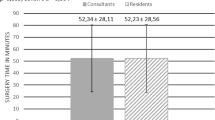Abstract
Development of surgical expertise and technology has affected the way renal tract stones are treated. Our hypothesis was that flexible ureteroscopy (FURS) for upper tract stones in children produces good results. Our outcomes were reviewed. A retrospective case note review was performed for children with upper tract calculi who were treated by FURS. There were 56 stone episodes in 36 patients. Median age was 10.6 years. Stones were 3–23 mm (median 8 mm); 64.3% had multiple calculi. Median follow-up was for 17.1 months. After the first FURS there was stone clearance in 42/56 (75%). Although there were no immediate complications, two required re-admission; one with stent symptoms, the other with urinary infection. A second FURS was performed in 11, bringing the cumulative clearance to 89%, although this was often done as “another look” before stent removal. There was no statistically significant difference in stone clearance after first FURS for those with single stones (81.0%) compared to those with multiple stones (72.2%). Clearance rates of more than 70% after first FURS were achieved with stones of up to 17 mm. Unexpected disease was found and treated during FURS in 9 (16.1%) children. FURS is safe in children and good clearance rates are achieved. Multiple stones at different sites may be treated during the same treatment. In addition, FURS allows diagnosis and treatment of unexpected problems.


Similar content being viewed by others
References
Lottmann HB, Traxer O, Archambaud F, Mercier-Pageyral B (2001) Monotherapy extracorporeal shock wave lithotripsy for the treatment of staghorn calculi in children. J Urol 165:2324–2327
Smaldone MC, Corcoran AT, Docimo SG, Ost MC (2009) Endourological management of pediatric stone disease: present status. J Urol 181:17–28
Ishii H, Griffin S, Somani BK (2015) Ureteroscopy for stone disease in the paediatric population: a systematic review. BJU Int 115:867–873
Smaldone MC, Cannon GM, Wu H-Y, Bassett J, Polsky EG, Bellinger MF, Docimo SG, Schneck FX (2007) Is ureteroscopy first line treatment for pediatric stone disease? J Urol 178:2128–2131
Tanaka ST, Makari JH, Pope JC, Adams MC, Brock JW, Thomas JC (2008) Pediatric ureteroscopic management of intrarenal calculi. J Urol 180:2150–2153
Abu Ghazaleh LA, Shunaigat AN, Budair Z (2011) Retrograde intrarenal lithotripsy for small renal stones in prepubertal children. Saudi J Kidney Dis Transpl 22:492–496
Erkurt B, Caskurlu T, Atis G, Gurbuz C, Arikan O, Pelit ES, Altay B, Erdogan F, Yildirim A (2014) Treatment of renal stones with flexible ureteroscopy in preschool age children. Urolithiasis 42:241–245
Uygun I, Okur MH, Aydogdu B, Arayici Y, Isler B, Otcu S (2012) Efficacy and safety of endoscopic laser lithotripsy for urinary stone treatment in children. Urol Res 40:751–755
Badawy AA, Saleem MD, Abolyosr A, Aldahshoury M, Elbadry MSB, Abdalla MA, Abuzeid AM (2012) Extracorporeal shock wave lithotripsy as first line treatment for urinary tract stones in children: outcome of 500 cases. Int Urol Nephrol 44:661–666
Brinkmann OA, Griehl A, Kuwertz-Bröking E, Bulla M, Hertle L (2001) Extracorporeal shock wave lithotripsy in children. Efficacy, complications and long-term follow-up. Eur Urol 39:591–597
Defoor W, Dharamsi N, Smith P, Sekhon D, Colombo J, Riden D, Reddy P, Sheldon C, Minevich E (2005) Use of mobile extracorporeal shock wave lithotripter: experience in a pediatric institution. Urology 65:778–781
Mokhless IA, Abdeldaeim HM, Saad A, Zahran AR (2014) Retrograde intrarenal surgery monotherapy versus shock wave lithotripsy for stones 10 to 20 mm in preschool children: a prospective, randomized study. J Urol 191:1496–1499
Tejwani R, Wang H-HS, Wolf S, Wiener JS, Routh JC (2016) Outcomes of Shock Wave Lithotripsy and Ureteroscopy for Treatment of Pediatric Urolithiasis. J Urol 196:196–201
Freton L, Peyronnet B, Arnaud A et al (2017) Extracorporeal Shockwave Lithotripsy Versus Flexible Ureteroscopy for the Management of Upper Tract Urinary Stones in Children. J Endourol 31:1–6
Lingeman JE, Kim SC, Kuo RL, McAteer JA, Evan AP (2003) Shockwave lithotripsy: anecdotes and insights. J Endourol 17:687–693
Krambeck AE, Gettman MT, Rohlinger AL, Lohse CM, Patterson DE, Segura JW (2006) Diabetes mellitus and hypertension associated with shock wave lithotripsy of renal and proximal ureteral stones at 19 years of followup. J Urol 175:1742–1747
Traxer O, Thomas A (2013) Prospective evaluation and classification of ureteral wall injuries resulting from insertion of a ureteral access sheath during retrograde intrarenal surgery. J Urol 189:580–584
Eryildirim B, Turkoglu O, Goktas C, Kavukoglu O, Guzel R, Sarica K (2018) Radiologic evaluation of children prior to SWL: to what extent they are exposed to radiation? Urolithiasis 46:485–491
Author information
Authors and Affiliations
Corresponding author
Ethics declarations
Conflict of interest
Ahmed Suliman: no potential conflicts of interest. Tariq Burki: no potential conflicts of interest. Massimo Garriboli: no potential conflicts of interest. Jonathan Glass: no potential conflicts of interest. Arash Taghizadeh: no potential conflicts of interest.
Human participant and animal rights statement
This research involved human participants. This research is based on retrospective review of treatment outcomes; in accordance with our Institution’s policy neither ethics committee approval nor informed consent from the patients or their parents was sought for this research. Fully informed consent for treatment was given by parents, guardians and subjects.
Rights and permissions
About this article
Cite this article
Suliman, A., Burki, T., Garriboli, M. et al. Flexible ureterorenoscopy to treat upper urinary tract stones in children. Urolithiasis 48, 57–61 (2020). https://doi.org/10.1007/s00240-018-1083-5
Received:
Accepted:
Published:
Issue Date:
DOI: https://doi.org/10.1007/s00240-018-1083-5




